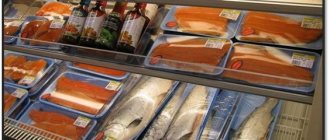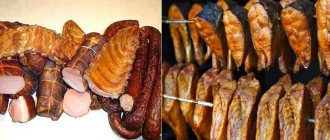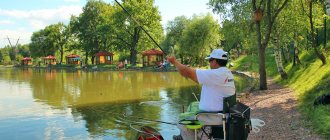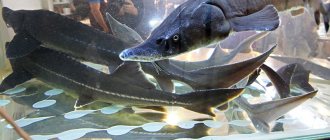Fish is one of the most promising, but also the most problematic product categories. On the one hand, no one doubts the value of this product, on the other hand, there are a lot of restrictions, material and intangible, that hinder the growth of fish consumption and the development of this category in Russian retail.
A varied assortment of fish in the store makes it possible to differentiate yourself from competitors, increase traffic and attract more fans of a healthy lifestyle.
However, in Russian stores the choice of fish is usually small. There are a lot of reasons. One of them is the inability of retailers to work with this product.
At the conference “Fish and seafood: global trends in retail sales and best Russian practices”, held by the Retail.ru portal as part of the WorldFood Retail Academy , representatives of the chains shared their practices and problems in the development of the fish category.
How much fish do Russians consume?
According to the Fisheries Information Agency, in 2020, the consumption of fish and seafood in Russia, taking into account imports, is no more than 12.9 kg per person per year (in marketable weight, that is, without trimmings, fins, heads, tails, intestines and offal) . Whereas the recommended volume of consumption of fish products by the Ministry of Health of the Russian Federation is 22 kg per person per year.
Since 2020, fish consumption has fallen by almost 25%, although catches increased from 4.4 million tons to 5.1 million tons in 2020. The maximum fish consumption—17.1 kg per Russian per year—was recorded in 2012.
Fish has long ceased to be a cheap alternative to meat, and gourmet varieties are much more expensive than meat. Fishermen prefer to work for export, but on the domestic market, fish is becoming less and less accessible to Russian buyers, since from 2013 to 2020 the price of fish has doubled and continues to rise in price. For example, in September of this year the price of red fish increased significantly
Fish risks
Fish as a commodity category is complex to handle and risks remain quite high throughout the supply chain due to short shelf life and high processing costs. According to the director of the category management department of the Moscow district of the Magnit chain, Andrey Ignatov , the main danger for the retailer is incorrectly predicted volume: expensive goods are quickly tracked, and this can negatively affect profitability.
An important disadvantage is low logistics accessibility and difficulties in providing a wide range of different types of fish and seafood. The product becomes expensive due to high production costs and the need to strictly maintain temperature conditions throughout the supply chain. Due to the short shelf life of fish, there is a high percentage of waste.
The most potential, but also the most problematic group is fresh chilled fish.
“Chilled fish is an amazing category, as it significantly adds points to the store,” says Andrey Ignatov. “But on the other hand, there is a danger that when fish cakes, when equipment is misused or fails, the smell of stale fish immediately spreads throughout the entire sales floor.”
The features of the category complicate the work. Fish as a product has high nutritional but low energy value. To get enough of this product, you need to buy more of it than meat, both in weight and price.
The category is very emotional and highly dependent on tastes and eating habits.
Despite the fact that the Russian Federation has access to 23 seas and includes more than 30 thousand reservoirs, that is, it has the ability to provide supplies of fresh fish, most regions (except historically fish ones - the North-West, South and Far East) are accustomed to working with frozen products.
All these conditions cause low consumption: for example, in the Magnit chain, according to Andrey Ignatov, the penetration of the category into the receipt, depending on the format and assortment of the store, ranges from 0.5 to 1.5%.
Ivan Fedyakov, General Director of InfoLine
“A healthy lifestyle in Russia is not a thrill, but a matter of survival. People are starting to learn to lead a healthy lifestyle so as not to get sick or lose their jobs, and this happens not only in the capital, but also in the regions. Getting sick is expensive, and while food prices are being sought to be kept down, medicines are rising in price at a high rate. Therefore, the healthy lifestyle category will invariably develop.”
Large fish: who divides the black caviar market in Russia
— It’s night, the border guards are chasing us, shooting. The owner of the boat is wearing a bulletproof vest.
And our boat is narrow, plastic, like a sports boat - are you watching racing? It squeezes out two thousand two hundred horsepower, you cling to the engine and fly! - a former poacher, and now an ordinary Astrakhan taxi driver loves speed and now, pressing on the gas of his car, deftly maneuvers between other cars on the road.
“The owner yells: “Jump!”, and I: “I’d rather sit it out!” So we went twice, and then I said: no, I’m quitting, my daughter is growing up. And there were so many cases: they shot, drowned, left. Pirates, Dagestanis-Magestanis. Who is to blame, who will find you at sea?
They say that in Astrakhan every second person is a poacher.
They are probably exaggerating about the city, but about the region, perhaps not: the fishing districts of Ikryaninsky, Limansky, Volodarsky and Kamyzyaksky, where almost half of the region’s population lives, are located in the lower Volga region: you left the house, set up a net - and here’s your catch.
However, you shouldn’t count on sturgeon. About 20 years ago, during spawning on the Volga, one could see the carcasses of sharp-nosed fish with ripped open bellies, floating with the current. The fishermen only took out the caviar and did not bother with the meat. Now there are almost no fish.
According to the latest data from Rosrybovodstvo (for 2013), in the Russian waters of the Caspian Sea there were less than 10 million sturgeon “fed” - fish “walking” in the sea and spawning in the river: 7.4 million Russian sturgeon fish, 1.1 million sturgeon and 1.2 million beluga. Previously, they counted in thousands of tons: at the end of the 70s there were 27,400 tons of fish.
“The poachers themselves say that there are no fish,” confirms Mikhail Shevyakov, deputy head of the Department for Combating Economic Crimes of the Ministry of Internal Affairs for the Astrakhan Region.
- In March, we detained over a ton of sturgeon - you can’t look at the fish without tears: about thirty centimeters, these are children. Previously, they didn’t take such things, now they choose the leftovers.”
Old-timers of the police still remember sturgeon from the 90s under two tons, and caviar that they tried to transport by KAMAZ trucks.
Industrial fishing of beluga was banned in 2000, Russian sturgeon and stellate sturgeon - in 2005.
The talkative taxi driver, who claims that during his poaching days he went by the nickname “Elusive,” went fishing in the Caspian Sea until 2010.
And in 2014, I gave up river fishing: “I caught the last sturgeon weighing 6 kg in my village. Then I decided to try myself on dry land - anything but fish,” explains the reckless driver.
Caviar instead of a hotel
In the early 2000s, a kilogram of Caspian sturgeon caviar could be bought in the markets of Astrakhan for 1,600 rubles; for 1 kg of fish they asked for 130 rubles.
“The cost of our fish when we started was 230 rubles per kg,” recalls Igor Bukatov, co-owner of Astrakhan, which is now one of the top three caviar producers in the region and one of the top five in the country (about 2 tons of caviar per year).
But the transition of sturgeon to the category of exclusive dishes was obvious: there was less caviar, and fishing was prohibited. Companies for raising sturgeon in captivity have appeared in Russia, most of them have mastered the method of “milking” fish - obtaining caviar “live” (another option, which Aquatrade also uses, is to slaughter caviar fish).
“When we invested the first money in this business, we believed that in three years we would already be driving a Porsche 911,” smiles Bukatov. He never bought a Porsche, he admits. I arrived at the restaurant to meet with a journalist in a Toyota Prado. Bukatov estimates the profitability of Aquatrade’s business in 2020 at 20%, and, seemingly jokingly, laments: “It would be better if we bought a hotel!”
There are several dozen producers of black caviar in Russia, less than ten large ones. According to Rosrybolovstvo, last year they produced just over 43 tons of caviar, of which 6.7 tons were exported. In 2006, when fishing in the Caspian Sea was just banned, according to estimates from a representative of the Traffic program, which studies trade in biological resources in Russia, there were over 500 tons of poached black caviar on the market.
“In the 2000s there was a golden time,” the ex-poacher-taxi driver says confidentially: I had 30,000 in my pocket, like 100 rubles now. I went to visit my mother and took the most expensive sweets.
Why, mom constantly saves money and buys caramels.” The taxi driver's earnings for Elusive are low, but life is calmer. The new wife is also keeping an eye on this: “Married!” is written on the mirror in the car’s interior in pink lipstick.
“Jealous,” he grins.
The volume of today's black market is a mystery: the police do not count, and CITES (Convention on International Trade in Endangered Species of Wild Fauna) estimates it at 200 tons. However, market participants claim that the figure is much lower: approximately 25% of total sales. Consultant of the agribusiness practice of the NEO Center Consulting Group Andrey Zhikharev agrees with them.
The retail price of black caviar is growing along with the dollar, now it is 30,000-70,000 rubles per kilogram, depending on the extraction method: “slaughter” costs more, “milk” costs less. The most expensive is beluga caviar - 90,000-150,000 rubles/kg, and sterlet caviar is 30% cheaper than sturgeon.
"Inexpensive idea"
The founder of Rybovodnaya LLC, Astrakhan resident Alexey Sokolov, sold this business two years after the start. Coming from the oilfield services company Schlumberger, Sokolov and five partners registered the company in 2002.
A year later, on the Bushma River near the village of the same name in the Astrakhan region, he built six fish cages with a total area of 150 square meters. m.
Having bought the first 500 kg of fry, Sokolov realized that the money had run out and the expenses had just begun, so he began looking for buyers for the asset and remembered his friend Igor Bukatov.
Bukatov and his business partner Anton Fedin were only on vacation in Astrakhan in the 2000s: they made money then by selling coking coal from Yakutia and Kuzbass; among their clients were the Federal Border Service and the Novolipetsk Metallurgical Plant (NLMK). The price of a promising business producing sturgeon and black caviar seemed low to them.
The first investments amounted to several million rubles. “In essence, we bought an idea for an inexpensive price that the creators didn’t have enough money for, thinking that it would pay off in three years,” says Fedin.
At the end of 2003, he and his partner became owners of about 8% of the shares of Aquatrade between them; by mid-2005, each of them increased their share to 39.2%.
Now Bukatov and Fedin have 47.4% each, and their friend Elena Pereverzeva has another 5.1%.
Sturgeons by Vladimir Lisin
The new owners of Aquatrade did not immediately realize the real price of the “inexpensive idea”.
“Why are there four cages - it’s like an aquarium at the dacha! But this aquarium began to eat up a lot of money: we hadn’t sold anything yet, but we were already transferring 350-400,000 rubles a month towards salaries,” recalls Anton Fedin.
Now the average salary for fishery specialists in the Astrakhan region is 12,000-15,000 per month, the minimum is from 6,000.
The next revelation for the owners of Aquatrade was the need to scale production. In 2003, the farm had 2 tons of fish. But based on the results of calculations, Fedin recalls, it turned out that for a normal business it is necessary to produce 100-150 tons, “then we will at least start earning something.”
Where can you get so many sturgeon? “Vladimir Lisin’s broodstock helped,” says Igor Bukatov. According to him, in 2003-2004, NLMK sold non-core assets, including three sturgeon production plants.
“The sturgeon were about twenty kilograms, good,” recalls Bukatov. – They were transported to some kind of cardboard factory, the fish were sitting in cages 2 by 2 m, sad, scary to look at. We bought 21 kilograms of fish for 400, they became the basis of our herd.”
The cost of live female sturgeon now depends on their species and age - from 10,000 rubles per kilogram.
NLMK's fish hatchery was indeed considered one of the largest industrial enterprises - by the way, the plant was a leader among metallurgists in fish production. NLMK's annual report for 2003 mentions CJSC Stalkonverst, which is engaged in fish breeding, processing and sales - NLMK had 36.8% there. In documents for 2004, the company is no longer on the list of affiliates.
The billionaire, who, without knowing it, took part in the fate of the Astrakhan company, recently received a present from it: “Lisin came to the Astrakhan region to hunt, and we found out about it and gave him a jar of caviar,” says Igor Bukatov.
Fish food
The owners of sturgeon farms do not look like tycoons at all. Pyotr Sabanchuk, deputy general director and co-owner of a fishmonger (ranked in the top seven in terms of production volumes in the Russian Federation), looks more like an ordinary hard worker than a businessman: a large man of about 60 driving a Renault Logan with an impressive crack on the windshield. He talks confidently and almost lovingly about the intricacies of fish production:
“Beluga matures like a girl: she doesn’t show up until she’s 16, and then you give her away in marriage.”
The beluga is really ready for spawning at 15-18 years old. Sturgeon begins to produce caviar only at seven or eight years old, sterlet at 4-6 years. Until three years of age, even the sex of the fish is unclear, which is determined very humanly: by ultrasound.
“Five years after the start, Aquatrade took its first right step in business,” Anton Fedin argues self-critically, “he stopped selling all the fish, starting to separate the males from the females.” By that time, the 170-ton sturgeon herd had already been divided into caviar and commercial sturgeon - the latter contained only male sturgeon for meat.
Until 2013, Aquatrade was the leader in the sale of sturgeon meat in the south of Russia, says the company’s commercial director Sergei Bessonov: the company sold 40-50 tons per year (now 20-30 tons per year). All the money was literally eaten up by the farm: feeding sturgeon is an expensive pleasure.
The fry are generally fed like children: every two hours. For a kilogram of fry - a kilogram of feed, which is bought in Europe. “If you need to raise 1 kg of fry, you need to spend 400 rubles on food.
50% of this fry will die in the process, but it will eat the food. That is, 1 kg of fish already costs 800 rubles,” Igor Bukatov makes a simple calculation. He sold three apartments in Moscow to feed Aquatrade's growing herd.
Now this herd reaches 260 tons and eats feed worth 60 million rubles per year.
Food for adult animals is already cheaper - “Raskat”, for example, buys them for 95 rubles per 1 kg. It is believed that during the season (summer) a six-year-old sturgeon gains 6-8 kg, says Olga Sabanchuk, general director of Raskat. For 1 kg of “gain” you need 3 kg of feed, which means that a season of feeding one fish like this costs 1,700-2,500 rubles. 1 kg of sturgeon in a store can be bought for 700-850 rubles.
“It was a great happiness for us that we only need to feed the fish in the warm season: in winter, sturgeon lie on the bottom and don’t need food,” says Anton Fedin. True, the owners of Aquatrade did not find out this right away.
The workers argued that in winter they needed to dig holes in the cages for feeding, says Fedin. “Maybe it was more convenient for them to catch fish from us - we realized that later.
But at some point I started experimenting at my dacha: it was minus 20 outside, we dug a hole, and after 15 minutes there was this layer of ice. And I began to think: “Why the hell does Aquatrade allocate money for holes?”
According to IFD Solid analyst Dmitry Lukashov, the cost of black caviar is about $350-400 per kg.
Now, 14 years after the start of the business, 80% of Aquatrade’s profit is spent on salaries, infrastructure support, consumables and food, says Bukatov.
Sergey Bessonov claims that the first revenue in this business comes after 10 years; investments, taking into account the cost of money over time, pay off after 12-15 years. Margins of 100% begin with 20 years of operation of the caviar herd, he expects.
“Don’t even try to start this business with less than 100-150 million rubles,” warns Bukatov. But the owner of the Russian Caviar Lux caviar distributor, Victor Kappes, who has been involved in the caviar business for about 30 years, estimates investments in cage farming for a hundred-ton sturgeon herd at $1 million, but makes a reservation: “It all depends on the volume: someone breeds sturgeon in a barrel "
“Do it beautifully!”
The initial investments of poachers are of a completely different order: “at a minimum: gear - about 50 pieces, a boat - about 50,000 rubles, a motor “thirty” (boat engine of 30 hp, - Forbes) - it costs 170,000-200,000 rubles .”, lists the ex-poacher “Elusive”.
This calculation is for single people: you won’t catch a lot of fish, but if you get caught by law enforcement officers, you won’t go to jail for long.
The classification of crimes depends not on the damage and volume, but on the method of commission: if you break the law alone, the punishment will be less severe than if in a group of people.
“You can eat the fish you catch and sell the caviar in the village without taking any risks - hucksters buy for 20,000 rubles. per kg,” explains the interlocutor. “At least 3-4 kg of caviar from sturgeon - that’s 80,000 rubles.”
Earnings are higher if you poach “for the owner” - a person with more serious equipment and connections - and constantly work in the Caspian Sea.
You can’t just get into the sea, says a law enforcement officer who participated in catching poachers: you have to pay for entry and exit, “like in our hospitals: give it for the operation and give it to the anesthesiologist so that he can survive the anesthesia.” Usually three people go out on a boat: a driver and two fishermen. They work on a percentage basis.
A successful solution is, for example, three large belugas - 50-70 kg of caviar. Such caviar costs on the black market from 30,000 rubles per kg. Then the fishermen receive 300-400,000 rubles “on the nose” from the owner.
The number of detected cases of poaching in Astrakhan has not changed over the past five years - about a thousand per year. 76 major crimes were solved in 2020, this is a third of all Russia, says Colonel Mikhail Shevyakov.
Source: https://www.forbes.ru/kompanii/potrebitelskii-rynok/323903-krupnye-ryby-kto-delit-rynok-chernoi-ikry-v-rossii
General recommendations
To increase sales of chilled fish, it is necessary to establish supply chains from production sites, clearly structure operational processes in the store, ensure the correct supply of the product and educate the consumer, instilling new habits.
“Trust in the store and its attractiveness are the most important things in sales,” explains Andrey Ignatov, “so everything should be fine here - all goods are accounted for and in stock, the necessary equipment is installed, all price tags are present, salespeople are behind the counter and cashiers are at the checkout. , you can’t live without it, it’s a classic. Chilled fish is more associated with emotions than other types of this product, so the feelings and impressions when interacting with the store are important, whether the buyer wants to go there and whether he trusts this store.”
You should clearly think through and follow the sales process - not just put it out in the morning and remove it in the evening, but build a production chain - for example, in the morning chilled fish is laid out for 3 hours, then removed from the display case and transferred to the semi-finished products workshop, after another 3 hours the semi-finished product goes to a hot dish . In this case, the store must fully feel and know its storefront; with this approach, write-offs do not increase, moreover, sales growth reaches double digits.
An important condition is a clear combination of price and quality, a clear product at a clear price.
Educate the customer about the product and provide personalized service through the use of fish experts.
It is optimal if there is a sales consultant behind the counter who can expertly talk about the product. It is correct to position fish as a healthy lifestyle product for those who watch their diet. Introduce dietary fish ready-made products and preserves into the assortment.
Make an effective presentation display to create a positive emotional image.
Andrey Evstratov, owner of the Okroshka chain (Murom, Vladimir region)
“The category driver is frozen fish packed in bulk. Chilled, hot smoked and preserved products have a small share of sales. The incomes of people in the regions are not growing.
Our buyer is an average and average minus, he doesn’t care how the fish is frozen or thawed, he first of all looks at the price tag. Maybe he is ready to buy a more expensive one, but does not have the opportunity. At the same time, there is a trend towards a healthy lifestyle, manufacturers produce products with greater added value, people say “I am for a healthy lifestyle,” but they eat pork.
Two years ago, our network held a promotion “Pink salmon at a price of 79 rubles. per kilogram,” the result was that sales of chilled meat and chicken, which cost about the same as fish, but had already become boring, collapsed. Then pink salmon made a sales plan.
With us, no one runs after suppliers: a tender is announced, and whoever gives the lowest price will be hired. Fish is bought less often also because it is more difficult to cook than chicken; not everyone knows how to do it correctly.”
White black caviar
The fish on the Popov farm is kept separately. The breeding herd is located in a separate building, in special pools. On the street, in cages, the fish is marketable, but here, under the roof and locks, it is the most valuable part of the farm.
Separately, female sterlet. They are planted according to the degree of maturity of the eggs. Among the black identical fish, a bright white spot suddenly appears. This is an albino sterlet. She has white caviar. That is, the taste is black, and the color is white. This product costs approximately 50 thousand dollars per kilogram.
And in the next pool there is an orange sterlet swimming.
“This is chromist,” says Andrey. — Such a fish is probably one in a million. We have already received caviar from her. It is bright black in color, with a shimmer.
There is also a pool with sturgeon nearby. Hefty males reluctantly splash around in the warm water. Among them are two albinos.
"Family" grows trust
The Perm chain “Semya” made store improvement its main strategy for 2019, including opening new departments, updating equipment and assortment. As part of this strategy, the fish department was equipped and the Chilled Fish project was launched.
The Semya chain has been operating in the Perm region since 2002, it includes 76 stores, including 4 hypermarkets (number of checks per day - 18,380, average check - 595 rubles), 26 supermarkets (42,556 checks, average check - 348 rubles), 46 convenience stores (59,933 receipts, average receipt - 288 rubles). There are 510 thousand owners of discount cards. The volume of tax payments for 2020 is 627.1 million rubles.
As Marina Nikitina, assortment management manager for the Semya chain, chilled fish is a growing category in the development of which the chain is ready to invest.
One of the main problems of the project is people’s distrust of chilled fish. At the same time, there is a growing interest in fish dishes as part of a healthy diet.
Buyers know that seafood in the diet provides the body with vitamin D, strengthens blood vessels, improves vision, and stabilizes sleep. It’s tasty and fashionable - not a single restaurant menu in the world is complete without fish dishes, many conceptual establishments on the theme of seafood are being created, and the media publish information about the benefits of fish. Why don't they buy?
“When talking to customers on the sales floor about why they rarely or never buy chilled fish, we received the following answers: “This is not chilled fish, I think the fish was just defrosted.” "Not the price I'm willing to pay." “Chilled fish may cost more than frozen fish, but not that much (frozen squid costs 190 rubles, and chilled squid costs 500 rubles).” “This is not the assortment that I need,” says Marina Nikitina.
Portal Retail.ru
regularly acts as organizer and co-organizer of professional industry events.
On December 10, 2020,
in partnership with the portal, it is holding a conference “How to make money by creating and developing retail chains?” for store owners, store managers and retail professionals. Join us!
To address customer concerns, the chain is working to improve trust.
The manager personally explains how the cooling process occurs, how the fish is processed and delivered, gives his phone number to the buyers of the fish department so that they can call and tell their vision, share their impressions of the product.
The most important thing is to convey the truth to the buyer, since it takes a long time to earn trust, but it’s easy to lose it - just a single mistake is enough, says Marina Nikitina.
If the steak is made from frozen raw materials that have been defrosted, then there is no need to hide it. The buyer will still understand this and lose the desire to trust.
In this process, the partnership of market players - networks and manufacturers, uniform standards and rules is important. The Semya chain lacks reliable suppliers who provide quality products and a wide range.
“I would like to offer the buyer a variety of fish and many ways to prepare it, so that a person cannot pass by the display case,” says Marina Nikitina. — We are waiting for partner suppliers of frozen and chilled fish. Our call to manufacturers: help respect the trust of customers in the storefront!”
According to the expert, chilled fish has growth potential, but frozen fish does not, so you need to:
- reduce the display of frozen fish in favor of chilled fish;
- expand the range of chilled products;
- increase turnover;
- reduce the retail price;
- follow the path of the meat market (internal production growth) taking into account the characteristics of the fish category;
- leave only high quality frozen products on the market.
To summarize, according to the expert, the chilled fish category can be developed, but it is necessary that everyone - from the manufacturer, purchaser to the buyer - be confident in the quality.
A fresh look at freezing
Freezing is often associated with a cheap and tasteless product. But the Fresh Frost chain of convenience stores decided to debunk this stereotype. The chain's assortment is based on frozen foods and ready-made meals. In particular, in the category “Fish and seafood” there are 30 SKUs, “Semi-finished fish products” - 20 SKUs, “Ready fish dishes” - 20 SKUs.
As Denis Babaev, general director of the Fresh Frost chain, , the convenience store has a small rotation of goods, since it is visited by 100–300 people a day, and with such traffic it is impossible to keep everything fresh and chilled, just as it is impossible to deliver fresh fish to the center of Russia.
But many buyers do not know that commercial fish does not come chilled. The fish stays on board the ship for up to three days and must be frozen within a few hours.
According to experts, the caught fish, after being lifted on board, is quickly sent for processing; no more than 5–8 hours pass from the moment the trawl is lifted to freezing. All technological operations are carried out directly at sea on board ships, as a result of which the fish does not lose its taste and freshness.
“We are trying to convey to the buyer that historically all seafood was delivered frozen from the place where it was grown or caught,” says Denis Babaev. — But in order to manipulate the concepts of healthy lifestyle and fresh, network companies devalue freezing. And freezing is the only way to deliver fresh product.”
Today frozen premium cakes and pastries, vegetables and berries have become familiar and popular, it’s time to transfer this attitude to fish. If you want fresh seafood, the store near your home will only have it frozen.
Chilled fish has development potential, says Denis Babaev, but only in the assortment of a specialized store or hypermarket with high traffic.
Alexander Turovtsev, Deputy General Director (Antey Group of Companies)
Finding your own store with high-quality freezing is very difficult. The chains “killed” freezing because they sold defrosted products, which they cut up, poured glaze into and froze again, ultimately getting a margin by deceiving the buyer.
It is necessary to tell customers that the highest quality fish is frozen within 4-5 hours after catching. However, no one can deny the benefits of fish grown under artificial conditions.
To set trends in the fish sales market, you need to understand what kind of product it is, where it comes from and how to apply it to a healthy lifestyle. Just 15 years ago, all the chains sold fish - whatever they needed, as long as there was a margin. Now the trend is changing - the range has expanded, people are trying to find the fish they like.
Networks that begin to work in tandem with the manufacturer will be successful, not when the processor is trying to sell, but when together they are trying to find a product that meets the buyer’s needs and teach the client how to use it correctly.







